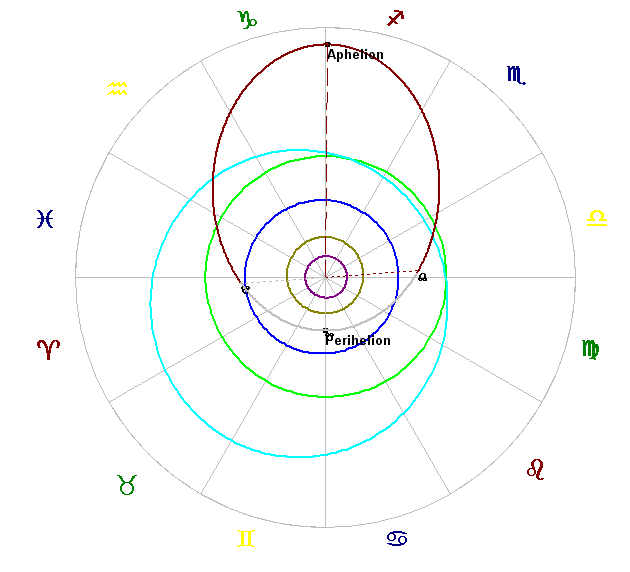
Die Bahn des 'Scattered Kuiper disc object' 1996 AS20
The orbit of the Scattered Kuiper disc object 1996 AS20

View 1996 AS20's orbit with the new 3D-Orbit-Viewer! (Java-applet)
Die Bahnen von Innen nach Außen:
Jupiter (lila), Saturn (goldgelb), Uranus (blau), Neptun (hellgrün)
und Pluto (hellcyan). Aphelion = Aphel = Sonnenfernster Punkt der
Bahn. Perihelion = Perihel = Sonnennächster Punkt der Bahn. Die
Knotenlinie markiert die Schnittebene zwischen der 1996 AS20-
und der Erdbahn. Wenn 1996 AS20 an einem der beiden Knotenpunkte
(aufsteigend = Bewegungsrichtung von Süden nach Norden;
absteigend = Bewegungsrichtung von Norden nach Süden) steht, so
befindet er sich mit 0° heliozentrischer Breite exakt in der
Ekliptikebene.
Hinweis: Die Klasse der sog. Scattered Kuiper Disc Objects ("verwackelte Kuiper-Scheiben-Objekte")
ist eng mit der Gruppe der Kentauren verwandt und wird auch auf der gleichen Internetseite des
Minor Planet Center zusammen mit den Kentauren aufgelistet. Der Unterschied besteht darin,
dass die SKOs ein große Halbachse a > 25 AE haben und somit wesentlich weiter über die Plutobahn
hinausragen, als dies bei Kentauren üblich ist (die per Definition hauptsächlich zwischen Jupiter und Pluto liegen).
Gleichzeitig überschneiden SKOs die Neptun- und
manchmal auch die Uranusbahn nach innen, weshalb sie nicht zu den Kuipergürtel-Planeten wie
z.B. die Plutinos (ähnliche Umlaufbahn wie Pluto in Neptunresonanz) oder Cubewanos
(benannt nach dem 1. echten Transplutonier 1992 QB1, dessen Bahn ausserhalb von Pluto verläuft und beinahe kreisförmig ist).
Gemeinsam mit den Kentauren haben die SKOs eine ähnliche hohe Exzentrizität und eine mehr oder wenig (langfristig gesehen) instabile Bahn.
SKOs sind sozusagen Bindeglieder und Brückenelemente zwischen den Kentauren und den Kuipergürtel-Planeten und
können auch als "ältere" Vorläufer-Kentauren gesehen werden, weshalb ich manche von ihnen hier auch aufführe.
1996 AS20 (dunkelrot) überkreuzt die Uranus-, Neptun und Plutobahn. Der hellgraue Teil der Bahn liegt unterhalb der Ekliptikebene. (Bahndarstellung unter Zuhilfenahme selbst programmierter Software (OrBITs2000, © Robert von Heeren und Dieter Koch, München-Zürich 1995-2002) und den von der Internationalen Astronomischen Union IAU in ihren Circulars und im Internet veröffentlichten oskulierenden Bahnelementen).
![]() The orbits from inside to outside: Jupiter
(lila), Saturn (dark yellow), Uranus (blue), Neptune (light green)
and Pluto (cyan). Aphelion = farthest
point from sun. Perihelion = nearest point to sun. The nodal axis
marks the intersection between the orbital planes of Earth and
1996 AS20. When 1996 AS20 (blue-green ellipse) crosses one of both
nodes (ascending = 1996 AS20 moves from south to north,
descending = 1996 AS20 moves from north to south), then its
heliocentric ecliptical latitude is 0°.
The orbits from inside to outside: Jupiter
(lila), Saturn (dark yellow), Uranus (blue), Neptune (light green)
and Pluto (cyan). Aphelion = farthest
point from sun. Perihelion = nearest point to sun. The nodal axis
marks the intersection between the orbital planes of Earth and
1996 AS20. When 1996 AS20 (blue-green ellipse) crosses one of both
nodes (ascending = 1996 AS20 moves from south to north,
descending = 1996 AS20 moves from north to south), then its
heliocentric ecliptical latitude is 0°.
Note: The so-called Scattered Kuiper disc objects are similar to Centaurs and are also listed together with
the Centaurs-group among the webpage of the Minor Planet Center. Although there are some differences between both groups:
the semi-major axis a is > 25 AU so that these bodies cross Pluto's orbit far more to the outside than the Centaurs do.
On the other hand they are not typical members of the Kuiper disc/belt because they cross Neptune's or even Uranus' orbit(s)
to the inside, which Kuiper belt objects like the Plutinos (similar orbit with Pluto, Neptune-resonance) or Cubewanos
(called after it's prototype 1992 QB1, the first discovered real trans-Pluto with nearly circular orbit) do not.
But SKOs have also similarities to the Centaurs: they share the same big eccentricites, cross major planet orbits and are therefore
over long periods of time unstable. In some way one can see them as "elder" Centaurs or proto-Centaurs and as bridges between the Centaurs
and the Kuiper-belt objects. This is the reason for me to list some of them at this site.
1996 AS20 (dark red ellipse) crosses the orbits of Uranus, Neptune and Pluto. The light grey part of the ellipse is located below the ecliptic plane.
Einige Daten zu den Eigenschaften von 1996 AS20:
Some datas for 1996 AS20:
Entdeckt am/discovered on 14.1.1996
Periode/Orbital Period P = 219,34 Jahre/years
Große Halbachse/ semimajor axis a = 36,37 AE/AU
Exzentrizität/eccentricity e = 0,62
Inklination/ inclination i = 10°36'
Durchmesser/ diameter = unbekannt/unknown
Eigenrotation/Rotational Period = unbekannt/unknown